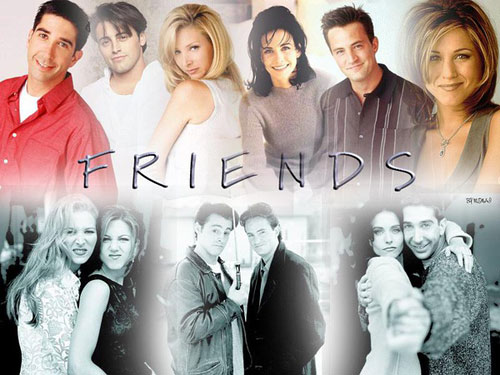当前位置: Language Tips> 双语新闻
How Friends is already the relic of a bygone era

|
Friends ended less than a decade ago, but it's already a relic of a bygone era--a critically respected network sitcom that enjoyed massive ratings. That's the central irony of the Must-See TV show's legacy: It was one of the last programs to enjoy a national audience before cable and the Internet fully segmented audiences, but the show itself prophesied that fragmentation through its 10-year-long portrait of increasing social segregation. Friends started out as a somewhat realistic (for network TV) exploration of metropolitan young (white) people, in the same way Roseanne sought to capture (white) working-class Midwestern life. In their original treatment, creators David Crane and Marta Kauffmandescribed the show as a look at "a time in your life when everything's possible," when the future was "more of a question mark." It was a Girls before Girls--Monica and Rachel are 24 when the show begins, just like Lena Dunham's Hannah--but much more optimistic because the economy hadn't yet vomited all over itself after another binge-and-purge cycle. Thus, it's no coincidence that so many of the complaints lodged against Friends--unrealistically expensive lifestyles, pervasive whiteness, youthful frivolity, all that sex--are now being recycled by the anti-Dunham crowd. Crane and Kauffman contrasted their show against traditional living-room and workplace sitcoms with a then-innovative, now-rote concept. "It's about friendship, because when you're single and in the city, your friends are your family," read the original pitch to NBC. (The peacock execs were apparently so uncomfortable with the idea of a show about twentysomethings that they suggested the creators add a middle-aged man to dole out fatherly advice. Perhaps that explains that NBC also-ran sitcom where Ernest Borgnineplayed Jonathan Silverman's BFF?) The great achievement of Friends' 10 seasons is that Crane, Kauffman, and executive producer Kevin S. Bright convincingly carried the sexy sextet through several life stages: marriage, parenthood, divorce, and the rocky, too-often humiliating road to a fulfilling career. But as the seasons progressed and its mythology expanded, the show shriveled, folding into itself. At the same time, the storylines became increasingly outlandish--the nadir of the head-scratching plots being Joey and Rachel's doomed romance--yet still somehow more depressingly realistic. The source of these two phenomena lay in the show's illustration that, as doors shut in your face during your twenties, you're not just increasingly penned in professionally, but also personally. The overarching narrative ofFriends charts how its characters' lives got smaller and narrower until they could no longer comfortably accommodate their makeshift friend-families--just a spouse and a child or two. Kauffman articulated the show's ethos of "maturity means friends or children" whenshe denied rumors of a follow-up to the show earlier this year. "Friends was about that time in your life when your friends are your family," she explained. "Once you have a family, there's no need anymore." To be fair, most sitcoms function as narrative islands. But from the start, Friends had sociological aspirations, making its observations of life as a post-collegiate lost soul in the big city more significant and purposeful than its time-slot neighbors likeSeinfeld and Frasier. And during the early years, there were good reasons for the sextet to stick so closely together. In the first two seasons, when the show hewed to its slice-of-life ambitions, money was a constant source of anxiety. Friendsimplied that the high cost of fun made a lot of activities off-limits; its New York was never the playground of luxury and fashion that is Sex and the City's Manhattan, not even for clotheshorse Rachel. Early in the second season, the show had its most explicit episode about income and friendships, where three of the have-not Friends--Phoebe, Rachel, and Joey--balk at their better-earning counterparts' plan to buy Hootie and the Blowfish tickets (heh) for Ross's birthday. Say what you will about the sextet's caffeine addiction--Scientific American certainly did--but those venti mugs probably didn't exceed $5. Since both lattes and talk are cheap, Central Perk kept the Friends together by offering itself as an economic oasis. The characters mostly take advantage of their urban environs by treating them as one long speed-dating assembly line. Friends relied heavily on the sitcom cliché of the Significant Other of the Week, a plot device that inevitably resulted in the SOW being dumped by the end of the episode, though some lasted a month or two. Especially in the earlier episodes, SOWs were routinely cast off because one of the other Friends disliked them. Over time, the repetition of the SOW storylines served to foster a loyal conformity among the Friends, as well as the creation and enforcement of a particular strand of promiscuous, gay-panicked, white-privileged, yuppie heterosexuality. The decade-long accumulation of rejected romantic partners eventually turned Friends' New York from a marketplace of possibilities to a menagerie of freaks, thus providing further incentive to stick to the clique. It makes sense that Phoebe, who marries Paul Rudd's Mike in the last season, was the exception to the rule, since she has the most tenuous connection to the rest of the characters. (According to Splitsider, she is also the only character who doesn't share a previous sex partner with any of her Friends.) By the show's end, having gone through all of white Manhattan, four of the six characters settle down with a mate from within their group. For all the cosmopolitan setting, then, the Friends eschew the romance of urban serendipity for incestuous familiarity. (This also explains the characters' lack of interest in people of other races--or even other boroughs.) Like a lot of ensemble sitcoms about single characters, Friends eventually becomes a screed against dating. The parade of flawed, unworthy, or just-not-right partners is so long that settling down with (and for) a good friend ultimately seems like the most sensible choice: better the Long Island Princess you know than the one you don't. (The Friendscopycat How I Met Your Mother goes even further in this regard by making its protagonist's two decades of dating merely a prelude to his wedded destiny, and explaining away its most promiscuous character's obsession with sex as the product of severe neurosis.) By the end of its run, the show groups its couples essentially by census bracket. The pairing of Monica with Chandler and Ross with Rachel unite the friends who are the most financially and ethnically similar (Rachel and the Gellar siblings are Jewish; Chandler is the Jew-adjacent kind of goy). Across town, masseuse Phoebe marries musician Mike, her "rightful" partner in anti-bougiedom. Friends has often been accused of being cash-stupid show--e.g., Monica and Rachel live in a huge West Village apartment despite no outward signs of being millionaires--but it's always been a very class-conscious one. Opposites may attract, but familiars breed. The ultimate sign of the show's tenet of "settling down as settling for who's around" is the reunion of the will-they-now-or-will-they-later couple, Ross and Rachel. It's a pairing that only worked in the early years because of David Schwimmer's hangdog eyes, and the relationship's initial dissolution was rather welcome, not least for bringing out a sarcastic edge and a screechy feistiness in Jennifer Aniston. Despite the characters' mutual attraction, they were always wrong for each other: Ross deserves a partner who's more intellectually challenging, Rachel one who's more fun. When they create a child and rekindle their romance in the show's last two seasons, their happy ending feels like a tragic death--of adventure, of idealism, of question marks. No longer so young, and yoked together by their kid, they see sense in trying to fall in love again, however many times it didn't work before. Their fate isn't written in the stars; it's dictated by two much more powerful forces: convenience and familiarity. |
《老友记》完结至今虽仅十年,却已成为一个逝去时代的遗产。作为最后几部国民级的剧集之一,《老友记》有着广大的观众群体,备受人们推崇和喜爱。在网络出现并开始与电视台争夺观众群之后,社会隔离现象逐渐加剧,这类“国民剧集”也开始销声匿迹。《老友记》的存在显得格外讽刺:长达十年的时间里,它对社会隔离现象的发展进行了细致的描绘,在某种意义上预言了这一隔阂的出现。(社会隔离:处于一种原有的社会联系逐渐减少以至于与社会隔离的状态) 与《罗西尼》中对中西部白人工人的刻画类似,《老友记》以写实的方式描绘了都市白人青年的生活状态。在最初的剧本大纲里,编剧大卫·柯拉尼和玛塔·卡夫曼将《老友记》定位为一部“表现人们生命中一段一切皆有可能的时期”的作品,在这段时期里,未来“就是大大的一个问号”。和《都市女孩》(Girls)中丽娜·杜汉姆饰演的汉娜类似,莫妮卡和瑞秋在剧集开始时都是24岁。但是相较而言,《老友记》中女孩的形象要更加乐观,因为当时经济还没有像后来的次贷危机时一样,因为过度低信用放贷而一发不可收拾。这也解释了许多人对《老友记》的质疑。就像他们不喜欢的《都市女孩》一样,《老友记》中不符合事实的昂贵生活作风,四处都是白人的社会环境,轻浮的年轻人,乱七八糟的性爱观,都让他们感到不快。 对比过去的客厅-办公室式情景喜剧,柯拉尼和卡夫曼采用了一种全新的即时创作手法,表现当下流行的种种观念。NBC最初把这部剧主题定位为“友谊”:当你孤身一人在大城市里,你的朋友就是你的家人。(那些高管们明显对于这个有关二十几岁年轻人的剧不满意,他们建议给剧中增加一些中年人的角色,以便适当的时候提出一些成熟的意见。这可能就是为什么NBC的另一部喜剧《The Single Guy》中,恩尼斯特·伯格尼演了乔纳森·斯利文曼的铁杆好友)。十年间,《老友记》的最大的成就莫过于两位编剧和制片人让这充满魅力的六人组携手经历人生种种:结婚,生子,离婚,艰难而曲折的追求自己的事业。 剧集一季接着一季登上荧幕,人气也越来越旺,可是剧情却开始变得干瘪无趣。故事情节莫名其妙,尤其是乔伊和瑞秋之间注定失败的感情线,至今都能让人感受到其中苦涩的现实感。这些现象让我们意识到,随着角色们年龄增长并进入二十岁后半,他们的职业和生活也将逐渐被各种条条框框所束缚,不像往日般自由而有趣。随着他们的生活逐渐稳定,娶妻生子,交际的圈子也变得越来越小,以至于到最后,没有一个人能很好的处理朋友与家庭的关系。 卡夫曼否认了《老友记》会推出后续电影的说法。“这部剧集讲的就是‘朋友即家人’的这样一个特殊的时期。”她解释道,“而一旦人们拥有了自己真正的家庭,这样的时期也就永远过去了。“ 大多数情景喜剧只是在简单的呈现,而《老友记》则从一开始就试图反映社会现实。它从一群刚刚毕业在城市里闯荡、内心迷茫的年轻人视角观察这个社会,并且以他们的方式将其呈现出来。与同时期的《宋飞正传》(Steinfield)和《欢乐一家亲)(Frasier)相比,这部剧显得更加具有社会意义。六个年轻人相互扶持,共同成长,在刚踏入社会时也非常有必要。 在前两季,《老友记》还坚持着反映现实的初衷,剧中主要困扰角色们的问题大多与金钱相关。诚然,他们所生活的纽约不是《欲望都市》(Sex and the City)中的曼哈顿,不是奢侈和时尚的游乐场,昂贵的消费水平使得许多娱乐活动受到限制,就连娇生惯养的瑞秋也不能大手大脚的花钱。第二季第五集以一种近乎露骨的方式表现了收入和友谊的关系——三个高收入的老友提出购买猫头鹰和河豚鱼乐队的演唱会门票作为罗斯生日礼物,而菲比、瑞秋和乔伊这三个穷光蛋则一直在试图回避这一话题。在剧中,这六个人咖啡的确喝的不少,且不管你如何看待这种行为(这是《科学美国人》的活儿),聚在一起喝咖啡绝对是一种便宜的联络感情方式。这样一杯咖啡,即便用剧中那种超大号的杯子,价钱也不会超过五美元。不用花什么钱,老友们就可以聚在一起和拿铁,侃大山。 住在城市里的一大好处就是恋爱机会源源不断。老友们像速配生产线一样闪电般的和不同的人约会。《老友记》使用了情景喜剧中的惯用套路:角色们的恋爱时间不会超过一个星期,本周的恋人无一例外的在该集结束后被甩掉。尤其在早期的剧集中,仅仅是因为其他老友们不喜欢某些”快餐恋人”,他们便会被老友们齐心协力的驱逐出剧。随着剧情的发展,这样的剧情一再上演,导致剧中逐渐形成了一种崇尚随性而为、反同性恋,且以白人主导的中上阶层青年恋爱风潮。 经过了十年间种种毫无意义的分分合合,纽约这个原本充满机遇的城市在观众看来俨然成了一帮被甩怪人的聚集地,这也使得老友们更加钟情于自己的小群体。这样看来,最后一季中菲比嫁给保罗·路德饰演的迈克也显得挺正常。作为唯一一个没有内部消化的老友,菲比是一个合情合理的例外。她与这个小团体的联系的确没有其他老友般深刻。(据Splitsider——国外一喜剧创作者网站分析,菲比是小圈子中唯一一个没有和其他老友拥有共同性伴侣的角色。) 在最后,在感受过曼哈顿各种类型的白人后,四个老友内部消化了。即便大都市中有这么多各式各样的人,这些老友们仍然放弃了都市邂逅的陌生浪漫,选择寻求老友间近乎乱伦的熟悉感。(这种心理也解释了为什么他们对其他种族甚至其他地区的人毫无兴趣。) 就好像许多围绕单身人物展开的情景喜剧一样,《老友记》也开始批判毫无意义的约会行为。在经历了一帮错误的不值得的有缘无分的伴侣后,老友们最终还是选择了身边的朋友。这样的选择看起来相当明智:熟悉的长岛公主怎么说也比陌生的性伴侣要来的好。(模仿《老友记》的《老爸老妈浪漫史》更加深入的讨论了这个问题。主角和种种不同的人谈了二十年恋爱才最终踏入婚姻殿堂。这部剧将种种滥交的行为解释成严重神经官能症的产物。) 在大结局中,几对伴侣的分组都有恰当的依据。莫妮卡和钱德勒,罗斯和瑞秋这两对的结合是出于经济情况和价值观念的契合。(瑞秋和盖勒兄妹都属于犹太教,而钱德勒虽然不是犹太教徒,但是在思维上与犹太教相近)菲比嫁给了音乐家麦克,他们在反社会地位主义上的立场使他们走到了一起。《老友记》常常因为角色与现实不符的经济情况而受人责难——莫妮卡和瑞秋住在纽约西区的一处大公寓里,这样豪华地段的住宅通常只有百万富翁才负担的起。就阶级层面来说,这种现象也令人疑惑。条件相差许多的两人可能会互相吸引,但是只有在各方面相似的人才会最终走到一起。 而最能体现出该剧“为身边之人驻足”这一主旨的,当属罗斯和瑞秋的复合。在观众看来,这对分分合合的小情侣在一起永远只是时间问题。他们俩在早期曾经在一起过。罗斯可怜巴巴的眼神令人同情,而瑞秋则显得歇斯底里又无理取闹,所以两人最初分手的时候,观众还挺满意。 尽管两人相互吸引,但他们却并不相配:罗斯应该找个更加聪明的姑娘,而他对于瑞秋而言又显得过于无趣。但是在最后两季,在有了孩子后,他们又开始试图寻回他们之前浪漫的感情。他们终成眷属,组成家庭,只是这一看似圆满的结局,更像是一场悲剧的终末——年轻的冒险、理想、种种未知数都已消失不见。不再年轻的他们仅仅因为孩子的存在而试图唤醒那根浪漫的神经,可是他们如何能成功?他们的人生不再如同浩瀚星海般广阔无垠,不可捉摸,而是被两种力量牢牢束缚:习惯与熟悉。 (译者 leewh 编辑 丹妮) 扫一扫,关注微博微信
  |
上一篇 : 科学家发现绝佳购物音乐
下一篇 : 福布斯排行榜:伦敦成为全球最具影响力城市
电话:8610-84883645
传真:8610-84883500
Email: languagetips@chinadaily.com.cn